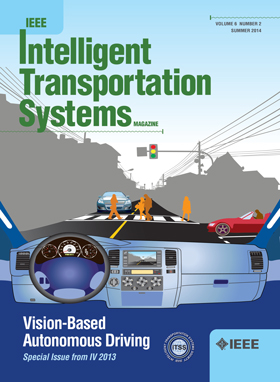Practical Distributed Control for Cooperative VTOL UAVs Within a 3-D Roundabout
IF 8.4
1区 工程技术
Q1 ENGINEERING, CIVIL
IEEE Transactions on Intelligent Transportation Systems
Pub Date : 2025-06-13
DOI:10.1109/TITS.2025.3570005
引用次数: 0
Abstract
With the rapid development of uncrewed aerial vehicle (UAV) technology in recent years, research on large-scale low-altitude UAV air traffic management (ATM) has gained attention. Unlike the traditional ATM, the number of small UAVs in the airspace may be in the millions, making air traffic management challenging. In an ATM, airspace is composed of airways, intersections, and nodes. In this paper, a three-dimensional (3-D) roundabout model is utilized as an airspace structure for air traffic intersections of known traffic network models, which is decomposed into a central island, several ramps, and buffer zones. In this paper, for simplicity, the distributed coordination of the motions of Vertical TakeOff and Landing (VTOL) UAVs to pass through a 3-D roundabout is focused on, which is formulated as a 3-D roundabout passing-through problem. The corresponding control objectives include inter-agent conflict-free, keeping within the 3-D curved virtual tube, and avoiding local minima. Lyapunov-like functions are designed elaborately, and formal analysis is made to show that all UAVs can pass through the 3-D roundabout without getting trapped. Taking the kinematic model of VTOL UAVs into consideration, the horizontal control and attitude control channels are decoupled, which is more reasonable for practical applications. Numerical simulation and real experiment are given to show the effectiveness of the proposed method.三维回旋处协同垂直起降无人机的实用分布式控制
近年来,随着无人机技术的快速发展,大型低空无人机空中交通管理(ATM)的研究受到了人们的关注。与传统的ATM不同,空域中的小型无人机数量可能达到数百万,这给空中交通管理带来了挑战。在ATM中,空域由航路、交叉口和节点组成。本文采用三维环形交叉口模型作为已知交通网络模型中空中交通交叉口的空域结构,将其分解为一个中心岛、若干匝道和缓冲区。为简单起见,本文主要研究垂直起降无人机通过三维回旋处时的分布式运动协调问题,将其表述为三维回旋处通过问题。相应的控制目标包括agent间无冲突、保持在三维弯曲虚拟管内、避免局部最小。精心设计了类李雅普诺夫函数,并进行了形式化分析,证明所有无人机都可以通过三维回旋处而不被困住。考虑垂直起降无人机的运动模型,将水平控制通道和姿态控制通道解耦,更符合实际应用。通过数值仿真和实际实验验证了该方法的有效性。
本文章由计算机程序翻译,如有差异,请以英文原文为准。
求助全文
约1分钟内获得全文
求助全文
来源期刊

IEEE Transactions on Intelligent Transportation Systems
工程技术-工程:电子与电气
CiteScore
14.80
自引率
12.90%
发文量
1872
审稿时长
7.5 months
期刊介绍:
The theoretical, experimental and operational aspects of electrical and electronics engineering and information technologies as applied to Intelligent Transportation Systems (ITS). Intelligent Transportation Systems are defined as those systems utilizing synergistic technologies and systems engineering concepts to develop and improve transportation systems of all kinds. The scope of this interdisciplinary activity includes the promotion, consolidation and coordination of ITS technical activities among IEEE entities, and providing a focus for cooperative activities, both internally and externally.
 求助内容:
求助内容: 应助结果提醒方式:
应助结果提醒方式:


